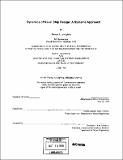Dynamics of naval ship design : a systems approach
Author(s)
Laverghetta, Thomas A. (Thomas Andrew), 1968-
DownloadFull printable version (14.52Mb)
Advisor
Alan J. Brown.
Terms of use
Metadata
Show full item recordAbstract
The 1990 Naval Sea Systems Command Ship Design, Acquisition and Construction (DAC) Study provides a stepping stone for the implementation of improvements towards optimizing ship performance, cutting acquisition costs, and reducing design cycle time. With respect to performance, significant advances in computing power coupled with customer oriented design (QFD, AHP, evolutionary optimization, etc) provide both improvements and direct means to measure effectiveness of improvements. As for cost, implementation of world class building and design techniques (concurrent engineering, group technology, CAD/CAM/CAE, etc) coupled with higher fidelity costing methods (ACEIT, PODAC, etc) provide savings and direct measures of effectiveness. Cycle time improvements have also been implemented (IPTs, Open System Architecture, 3-D Product Models, etc). However, ship design managers have been unable to identify and quantify design process effectiveness with respect to the impact of those proposed cycle time improvements. In order to understand the impact of cycle time improvements, it is necessary to examine the mechanisms which have lead to increased cycle time including external influences (such as increasing technological complexity and budgetary pressures), internal process delays (information flow delays and approval delays) and feedback processes (design iteration, error propagation and design change.) Modeling of such mechanisms, using the methods of System Dynamics, provides a means to study past programs (in particular, the DDG-51Destroyer program of the 1980' s), and to study the anticipated savings that can be generated with the introduction of process improvements. Of particular interest in modeling the naval ship design process with System Dynamics is the flow of design information. Traditional process analysis methods based on the design spiral represent the progression of design tasks as a linear process. However, actual design data propagation (a fundamental property resulting from the physical and architectural relationships of total ship systems) shows the process to be highly non-linear. These nonlinearities are captured by system dynamics, providing a simulation tool that more fully captures the impacts of process improvements as they relate to the naval ship design process.
Description
Thesis (Nav.E. and S.M.)--Massachusetts Institute of Technology, Dept. of Ocean Engineering, 1998. Includes bibliographical references (p. 133-136).
Date issued
1998Department
Massachusetts Institute of Technology. Department of Ocean EngineeringPublisher
Massachusetts Institute of Technology
Keywords
Ocean Engineering